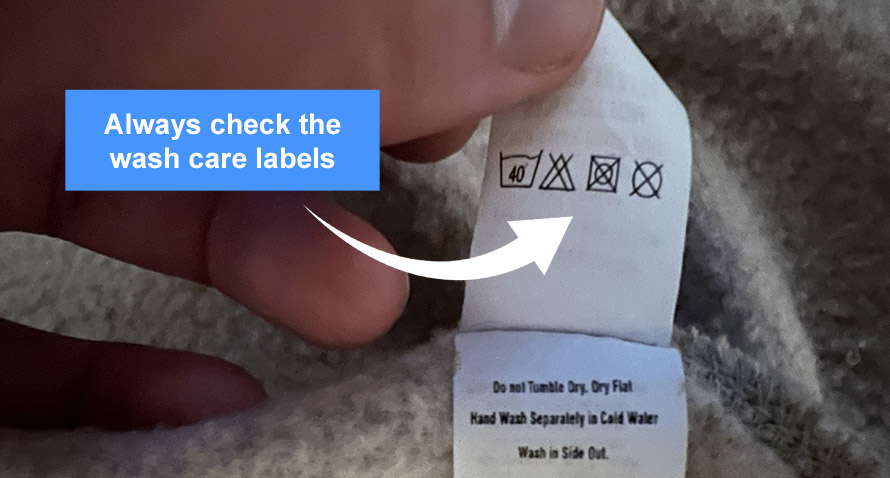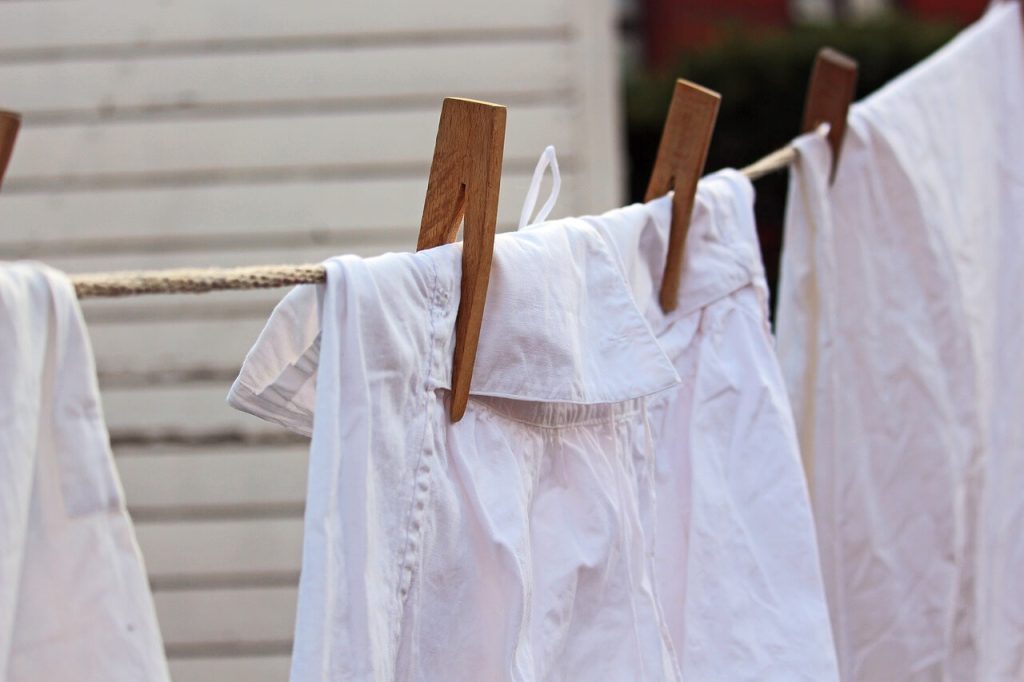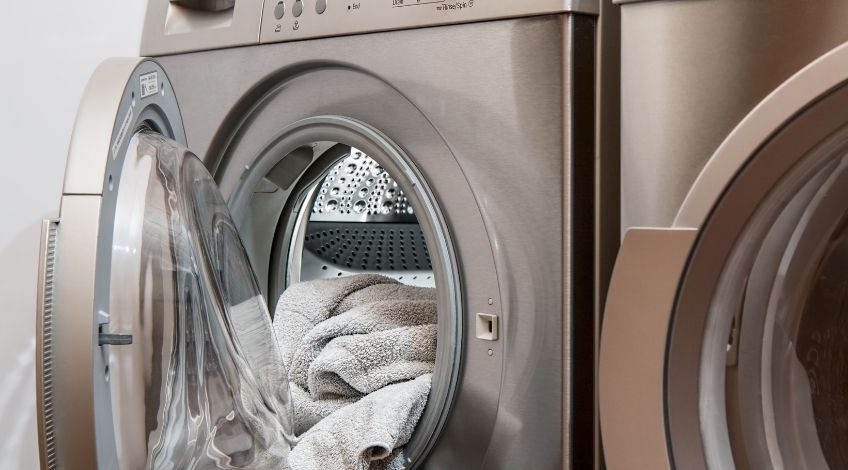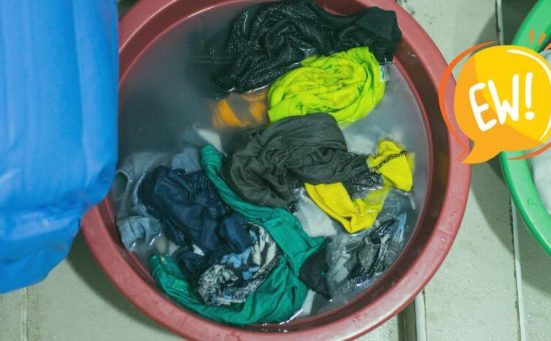
What Temperature Is Best To Wash White Clothes At?
Keeping white clothes white can be challenging especially if you wash them at the wrong temperature. This is made even more difficult because the main consideration isn’t the colour of the clothes. What’s more important is the fabric the clothes are made from.
It’s the fabric that determines how hot or cold the wash water needs to be to safely and successfully get your whites clean.
Generally speaking, higher wash temperatures are most likely to remove stains and dirt from clothes whether they’re white or not. Which should mean that if you want to get your whites brilliant white, you’ll need to use a hot wash cycle.
The problem with that is many fabrics will become damaged, shrink or tear if washed in water that is too hot.
Should Whites Be Washed In A Hot Or Cold Wash?
The temperature you choose to wash your whites at should be determined by a couple of factors;
- The Material They’re Made From
It’s not the colour of the laundry that matters, it’s the material they’re made from that makes the biggest difference when deciding how to wash clothes. There are many fabrics that cannot and should not be washed in hot water. They’re likely to shrink, tear, become misshapen or in some cases stretch. - The Type Of Stains you Need To Remove
Many stains and dirt need to be washed in hot water to remove them easily. However, there are some like blood and milk based stains that actually get cooked onto the fabric if you use a wash that is too hot.
Added to this, washing white laundry in a hot wash every time is not so good for the environment or your bank balance. Which is why it’s a good idea to find out which temperature will suit the needs of the white fabrics you need to get clean.
Always Check The Wash Care Label First

There’s more to washing clothes than just separating whites from darks and colours and washing each pile separately. You also need to wash items at the correct temperature to ensure that the item doesn’t become damaged, torn or shrink in the wash.
The first step when washing any clothes regardless of their colour, is to check the wash care label. Manufacturers want you to get the best from your clothes which is why they take the time to let you know the best way to look after them.
On the wash care label you’ll see a symbol that represents a bucket filled with water along with a number. That number lets you know the recommended temperature the garment should be washed at.
If the bucket symbol has 30 in it, that indicates that the item should be washed at 30 degrees C. If it has a 40 in it, that indicates it should be washed at 40 degrees and so on.
This doesn’t mean that you can’t wash the items at a lower temperature, just that your water temperature shouldn’t exceed that temperature.
When Should You Wash Whites In Hot Water?
You should use a hot water wash if the whites are very dirty or have ingrained stains. This is of course dependent on the fabrics being safe to wash at high temperatures.
Hot water is good for removing stains and killing bacteria and germs too. If someone at home has been ill, and the fabric allows, you should wash their whites in a hot water wash.
When Should You Wash Whites In Cold Water?

Washing clothes in cold water is the gentlest way to get them clean. Cool water wash cycles are less likely to cause clothes to shrink or become damaged in the washing machine. We would recommend always erring on the side of caution and washing your clothes, whether white or not, at the lowest temperatures possible.
Delicates should always be washed on a cool wash (30 degrees) using a delicate or hand wash cycle. It is always the best policy when washing clothes at low temperatures that you also select a gentle wash cycle. You should also use a specially formulated detergent designed for use at low temperatures.
There are a few problems associated with washing clothes at low temperatures which include;
- The Water’s Not Hot Enough To Remove Many Stains
Those heavily soiled white garments might not get clean even with the correct detergent on a cool wash. You might need to pre-soak or pretreat severely stained white clothes before washing in the machine on a cool wash. - The Water’s Not Hot Enough To Kill Germs & Bacteria
There are many germs and bacteria that can survive a cool wash cycle. This can be problematic especially if those white clothes belong to someone who is ill. To combat this, you should use a laundry sanitiser as well as a specially formulated cool wash detergent. - The Machine Will Need A Hot Service Wash Once A Month
If you constantly wash your clothes using a cool wash cycle, your machine will get a build up of dirt, soap scum, germs, bacteria and mould spores. This can lead to bad smells coming from the machine as well as your laundry actually picking up bacteria as it gets washed. You should run a hot (90 degree) service wash once a month to remove any build up of germs, bacteria, dirt etc.
The Best Way To Wash Whites In The Washing Machine

To ensure that your whites get as clean and bacteria free as possible, you should always wash them using the hottest water recommended for that particular fabric. This will ensure most of the dirt is removed without having to worry about the items shrinking.
You should always add a laundry sanitiser when washing at lower temperatures to help combat the problem of germs and bacteria.
Even if your fabric allows a hotter wash cycle, you should always opt for a gentle cycle.
Pretreating Stains
The majority of stains can be removed even at lower temperatures as long as you pretreat the stains before washing. These stain pretreatments should be used at the recommended temperature for the fabric that needs cleaning.
Some stains like blood, red wine, coffee, chocolate and milk based stains should be washed at cooler temperatures because heat bakes them into the fabric. This means pre-soaking or pretreating the stain before washing is the safest way to remove them.
Should Whites Be Washed In Hot Water?
Back in the olden days, whites would be boiled in large pots for hours on end to remove stains and bring the brightness back to the clothes. This has become part of our way of thinking but these days it’s not necessary.
As washing machine technology and detergent manufacture have improved, it is possible to wash whites at way lower temperatures. All you need is a specially formulated cool wash detergent and a gentle setting coupled with a laundry sanitiser to ensure your whites are physically and hygienically clean.
Should You Use Fabric Softener On Whites?
It is not a good idea to use fabric softener on whites. This is because a build up of softener can make whites look grey. If your whites need softening you should use white vinegar instead.
SEE ALSO: What Temperature Is Best To Wash Clothes At?
Frequently Asked Questions
The temperature that is best for washing white clothes is dependent on the material used to make them. Always consult the wash care label and stick to the recommendations made in them.
There is no specific temperature for a white wash, it all depends on the fabric used to make the clothes. You should check the wash care label before washing any clothes.
There are some whites that can be washed at 60 degrees, white towels for example. You should always check the wash care label before washing any items.
Also, follow us on Pinterest ...



